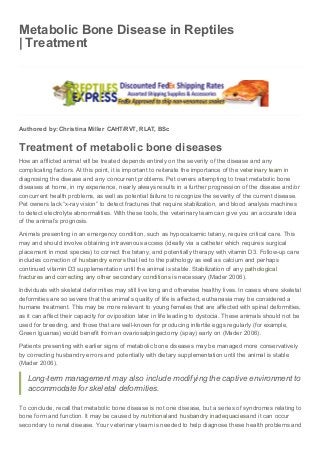
Metabolic bone disease in reptiles treatment
- 1. 09/04/2015 Metabolic Bone Disease in Reptiles | Treatment data:text/html;charset=utf-8,%3Cheader%20class%3D%22entry-header%22%20style%3D%22display%3A%20block%3B%20clear%3A%20both%3B%20c… 1/2 Metabolic Bone Disease in Reptiles | Treatment Authored by: Christina Miller CAHT/RVT, RLAT, BSc Treatment of metabolic bone diseases How an afflicted animal will be treated depends entirely on the severity of the disease and any complicating factors. At this point, it is important to reiterate the importance of the veterinary team in diagnosing the disease and any concurrent problems. Pet owners attempting to treat metabolic bone diseases at home, in my experience, nearly always results in a further progression of the disease and/or concurrent health problems, as well as potential failure to recognize the severity of the current disease. Pet owners lack “x-ray vision” to detect fractures that require stabilization, and blood analysis machines to detect electrolyte abnormalities. With these tools, the veterinary team can give you an accurate idea of the animal’s prognosis. Animals presenting in an emergency condition, such as hypocalcemic tetany, require critical care. This may and should involve obtaining intravenous access (ideally via a catheter which requires surgical placement in most species) to correct the tetany, and potentially therapy with vitamin D3. Follow-up care includes correction of husbandry errors that led to the pathology as well as calcium and perhaps continued vitamin D3 supplementation until the animal is stable. Stabilization of any pathological fractures and correcting any other secondary conditions is necessary (Mader 2006). Individuals with skeletal deformities may still live long and otherwise healthy lives. In cases where skeletal deformities are so severe that the animal’s quality of life is affected, euthanasia may be considered a humane treatment. This may be more relevant to young females that are affected with spinal deformities, as it can affect their capacity for oviposition later in life leading to dystocia. These animals should not be used for breeding, and those that are well-known for producing infertile eggs regularly (for example, Green Iguanas) would benefit from an ovariosalpingectomy (spay) early on (Mader 2006). Patients presenting with earlier signs of metabolic bone diseases may be managed more conservatively by correcting husbandry errors and potentially with dietary supplementation until the animal is stable (Mader 2006). Long-term management may also include modifying the captive environment to accommodate for skeletal deformities. To conclude, recall that metabolic bone disease is not one disease, but a series of syndromes relating to bone form and function. It may be caused by nutritionaland husbandry inadequaciesand it can occur secondary to renal disease. Your veterinary team is needed to help diagnose these health problems and
- 2. 09/04/2015 Metabolic Bone Disease in Reptiles | Treatment data:text/html;charset=utf-8,%3Cheader%20class%3D%22entry-header%22%20style%3D%22display%3A%20block%3B%20clear%3A%20both%3B%20c… 2/2 Remember this Leopard Gecko from part 1? He is displaying poor posture, an overbite, and scoliosis of the distal tail, all suggestive of NSHP. to determine the severity of the patient’s disease. Treatment involves stabilizing the animal and treating any secondary health problems, and identifying and subsequently correcting the husbandry errors that contributed to the disease initially. Some patients will have an excellent prognosis, sometimes even with skeletal deformities. Of course, prevention is the best medicine, and educating yourself about the husbandry needs of your pet herp is undoubtedly one of the most important things you can do as a pet owner. References: Mader, DR. 2006. Metabolic Bone Diseases. In: Reptile Medicine and Surgery (2nd edition). DR Mader (editor)
